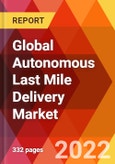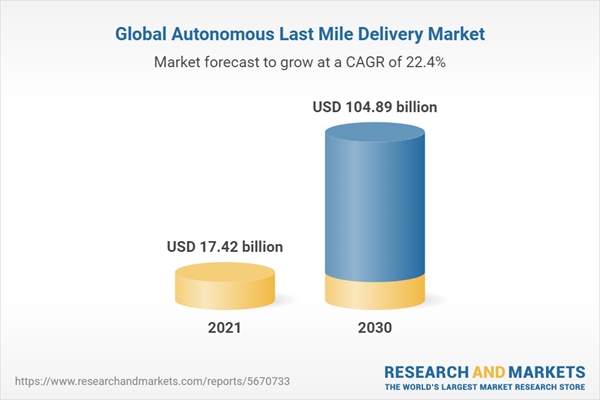The global autonomous last mile delivery market held a market value of USD 17.42 billion in 2021 and is estimated to reach USD 104.89 billion by the year 2030. The market is anticipated to register a CAGR of 22.4% during the forecast period. The autonomous last mile delivery industry held market volume of 9 million units in 2021.
Autonomous last mile delivery constitutes the last stage of the courier where the parcel is sent to the end users at their doorsteps without any human intervention. The autonomous delivery is done through the usage of autonomous vehicles, drones, robots, and so on. The rise in robots, aerial delivery drones, and self-driving vehicles have contributed heavily towards the growth of the industry.
The increasing strategic initiatives by prominent players in the industry boosts the growth rate of the market. for instance, in April 2021, United Parcel Service agreed to acquire 10 electric vertical take-off and landing aircraft from Beta Technologies. UPS will test the eVTOLs for use in its Express Air delivery network, focusing on small and medium markets. Such moves aid the market growth. In contrary, the dearth of suited infrastructure for the support of all operations is hindering the growth of the market for autonomous last mile delivery industry.
By Component.
The North American market for autonomous last mile delivery held the largest market share of more than 55% in 2021 owing to the increasing strategic activities by prominent players.
In addition to that, the European region is anticipated to grow at a substantial rate owing to the rising awareness regarding this area. Moreover, the Latin American and Middle Eastern & African region is also anticipated to grow at a considerable rate.
The key four players in the market hold more than 20% of the market share. These market players are investing in product launches, collaborations, mergers & acquisitions, and expansions to create a competitive edge in the market. For instance, in October 2021, Altitude Angel, UTM (Unified Traffic Management) technology provider, unveiled its Guardian, UTM Enterprise platform which will be utilized by three consortiums trialing Beyond Visual Line of Sight (BVLOS) drone operations in India.
Autonomous last mile delivery constitutes the last stage of the courier where the parcel is sent to the end users at their doorsteps without any human intervention. The autonomous delivery is done through the usage of autonomous vehicles, drones, robots, and so on. The rise in robots, aerial delivery drones, and self-driving vehicles have contributed heavily towards the growth of the industry.
The increasing strategic initiatives by prominent players in the industry boosts the growth rate of the market. for instance, in April 2021, United Parcel Service agreed to acquire 10 electric vertical take-off and landing aircraft from Beta Technologies. UPS will test the eVTOLs for use in its Express Air delivery network, focusing on small and medium markets. Such moves aid the market growth. In contrary, the dearth of suited infrastructure for the support of all operations is hindering the growth of the market for autonomous last mile delivery industry.
Growth Influencers:
Technological advancements in delivery vehicles
Several researchers have pointed out to the benefits of utilizing delivery vehicles in several industries, including healthcare, retail, hospitality, logistics, and many others. In light of this, many companies are partnering up to sustain their business models, activities, and service portfolio. For instance, in September 2021, Zipline signed a service level agreement with the Kaduna State Government of Nigeria to use drones in the health supply chain system. The delivery is supposed to include daily medical supplies such as blood pints and medicines and plan delivery of COVID-19 vaccines. Therefore, this drives the market growth.Demand and development of aerial delivery drones
The preference rate for aerial delivery drones is consistently increasing and is expected to grow steadily over the anticipated period. The increase is in light of the reduction of pollution through the current ground delivery options available. Moreover, the aerial delivery drones which are designed for long range can travel up to 20 kilometres on a single charge. Thus, such measures drive the market growth.Segments Overview:
The global autonomous last mile delivery market is segmented into component, robot type, vehicle type, payload, application, industry, and location/destination.By Component.
- Hardware
- GPS
- Cameras
- Radars
- Ultrasonic/LiDAR Sensors
- Control Systems
- Chassis and Motors
- Batteries
- Others (Wires, Drive Wheels, and Relays)
- Software
- Robotic Operating System
- Cyber Security Solutions
- Services
- Integration, Maintenance & Support
- Consulting and Training
By Robot Type
- UAV/ Drones
- Fixed Wing
- Rotary Wing
- Hybrid
- UGV
- 2 Wheel
- 3 Wheel
- 4 Wheel
By Vehicle Type
- Aerial Delivery Drones
- Self-Driving Vehicles
- Trucks
- Vans
- Others
- Ground Delivery Bots
By Payload
- < 0.5 Kgs
- 0.5 - 2 kgs
- 2-10 Kgs
- 10-50 Kgs
- 50-100 Kgs
- 100 Kgs
By Application
- Food Delivery
- Cargo Delivery
- Medical Delivery
- Postal Delivery
- Emergency Response
By Industry
- Retail
- E-commerce
- Hospitality
- Healthcare
- Logistics
- Postal Services
- Others
By Location/ Destination
- Urban Delivery
- Rural Delivery
Regional Overview
By region, the global autonomous last mile delivery market is divided into Europe, North America, Asia Pacific, Middle East & Africa, and Latin America.The North American market for autonomous last mile delivery held the largest market share of more than 55% in 2021 owing to the increasing strategic activities by prominent players.
In addition to that, the European region is anticipated to grow at a substantial rate owing to the rising awareness regarding this area. Moreover, the Latin American and Middle Eastern & African region is also anticipated to grow at a considerable rate.
Competitive Landscape
The prominent players operating in the global autonomous last mile delivery market include Alibaba, Airbus S.A.S., Altitude Angel, BIZZBY, Amazon.com, Inc. (Amazon Prime Air), Boeing, DHL International GmbH, Cheetah Logistics Technology, DoorDash Inc., DroneScan, Kiwibot, Edronic, Fli Drone, FedEx, Flirtey Delivery Drone, JD.com, Inc., Flytrex, Matternet Inc., Parrot Drone SAS, Meituan-Dianping, Pudu Technology Inc, Skycart Inc., Rakuten Inc., SZ DJI Technology Co., Ltd, United Parcel Service of America, Inc., Terra Drone Corporation, UVL Robotics, Workhorse Group Inc., Wing Aviation LLC, Yuneec International, Zipline autonomous, among others.The key four players in the market hold more than 20% of the market share. These market players are investing in product launches, collaborations, mergers & acquisitions, and expansions to create a competitive edge in the market. For instance, in October 2021, Altitude Angel, UTM (Unified Traffic Management) technology provider, unveiled its Guardian, UTM Enterprise platform which will be utilized by three consortiums trialing Beyond Visual Line of Sight (BVLOS) drone operations in India.
The global autonomous last mile delivery market report provides insights on the below pointers:
- Market Penetration: Provides comprehensive information on the market offered by the prominent players
- Market Development: The report offers detailed information about lucrative emerging markets and analyzes penetration across mature segments of the markets
- Market Diversification: Provides in-depth information about untapped geographies, recent developments, and investments
- Competitive Landscape Assessment: Mergers & acquisitions, certifications, product launches in the global autonomous last mile delivery market have been provided in this research report. In addition, the report also emphasizes the SWOT analysis of the leading players.
- Product Development & Innovation: The report provides intelligent insights on future technologies, R&D activities, and breakthrough product developments
- Pricing Analysis: Pricing analysis of various metals and other components used in the manufacturing
- Manufacturing Cost Analysis: Cost-share of various components in autonomous last mile delivery, cost analysis of autonomous last mile delivery tools
- Cost of Last-Mile Deliveries
- Top Robots for Autonomous Last Mile Delivery
- Regulatory Framework
The global autonomous last mile delivery market report answers questions such as:
- What is the market size and forecast of the global autonomous last mile delivery market?
- What are the inhibiting factors and impact of COVID-19 on the global autonomous last mile delivery market during the assessment period?
- Which are the products/segments/applications/areas to invest in over the assessment period in the global autonomous last mile delivery market?
- What is the competitive strategic window for opportunities in the global autonomous last mile delivery market?
- What are the technology trends and regulatory frameworks in the global autonomous last mile delivery market?
- What is the market share of the leading players in the global autonomous last mile delivery market?
- What modes and strategic moves are considered favorable for entering the global autonomous last mile delivery market?
Table of Contents
Chapter 1. Research Framework
Chapter 2. Research Methodology
Chapter 4. Global Autonomous Last Mile Delivery Market Overview
Chapter 5. Global Autonomous Last-Mile Delivery Market Analysis, By Component
Chapter 6. Global Autonomous Last-Mile Delivery Market Analysis, By Robot Type
Chapter 7. Global Autonomous Last-Mile Delivery Market Analysis, By Vehicle Type
8.1. Key Insights
Chapter 9. Global Autonomous Last-Mile Delivery Market Analysis, By Application
Chapter 10. Global Autonomous Last-Mile Delivery Market Analysis, By Industry
Chapter 11. Global Autonomous Last-Mile Delivery Market Analysis, By Location/Destination
Chapter 12. Global Autonomous Last-Mile Delivery Market Analysis, By Region
Chapter 13. North America Autonomous Last-Mile Delivery Market Analysis
Chapter 14. Europe Autonomous Last-Mile Delivery Market Analysis
Chapter 15. Asia Pacific Autonomous Last-Mile Delivery Market Analysis
Chapter 16. Middle East & Africa Autonomous Last-Mile Delivery Market Analysis
Chapter 17. South America Autonomous Last-Mile Delivery Market Analysis
Chapter 18. Company Profile (Company Overview, Financial Matrix, Key Product landscape, Key Personnel, Key Competitors, Contact Address, and Business Strategy Outlook)
Companies Mentioned (Partial List)
A selection of companies mentioned in this report includes, but is not limited to:
- Airbus S.A.S.
- Alibaba
- Altitude Angel
- Amazon.com, Inc. (Amazon Prime Air)
- BIZZBY
- Boeing
- Cheetah Logistics Technology
- DHL International GmbH
- DoorDash Inc.
- Kiwibot
- DroneScan
- Edronic
- FedEx
- Fli Drone
- Flirtey delivery drone
- Flytrex
- JD.com, Inc.
- Matternet Inc.
- Meituan-Dianping
- Parrot Drone SAS
- Pudu Technology Inc
- Rakuten Inc.
- Skycart Inc.
- SZ DJI Technology Co., Ltd
- Terra Drone Corporation
- United Parcel Service of America, Inc.
- UVL Robotics
- Wing Aviation LLC
- Workhorse Group Inc.
- Yuneec International
- Zipline autonomous
Table Information
| Report Attribute | Details |
|---|---|
| No. of Pages | 332 |
| Published | September 2022 |
| Forecast Period | 2021 - 2030 |
| Estimated Market Value ( USD | $ 17.42 billion |
| Forecasted Market Value ( USD | $ 104.89 billion |
| Compound Annual Growth Rate | 22.4% |
| Regions Covered | Global |









